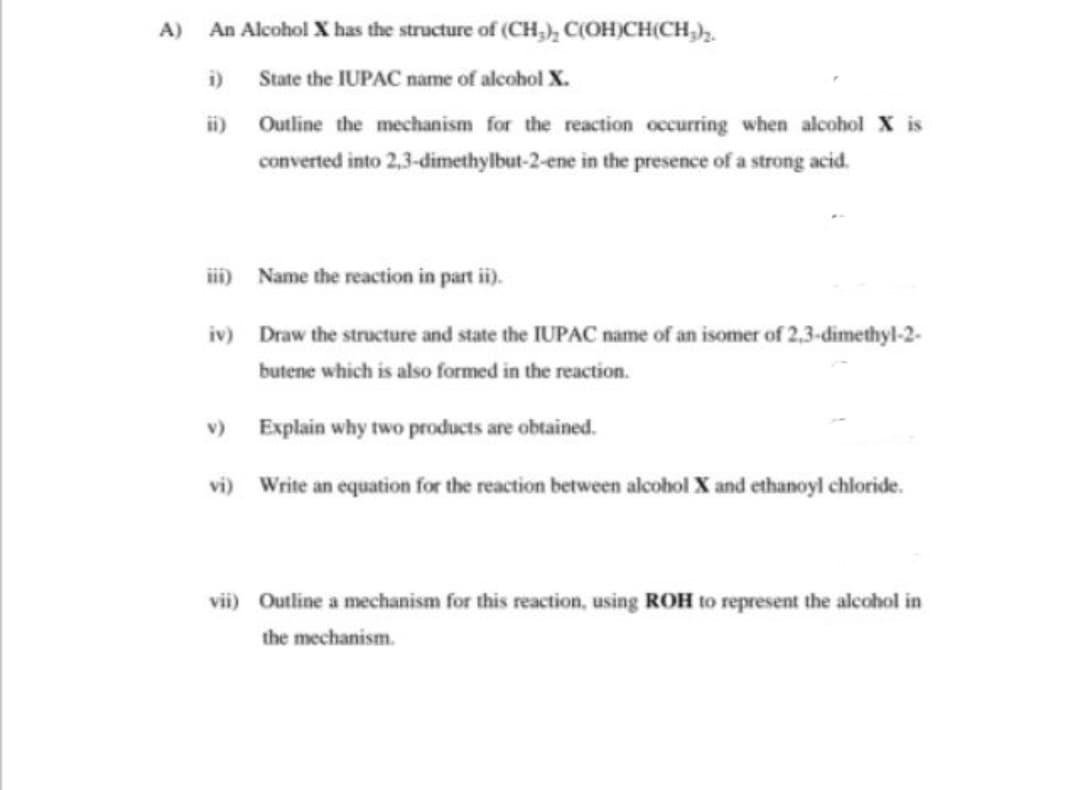A) An Alcohol X has the structure of (CH,), C(OH)CH(CH,),. i) State the IUPAC name of alcohol X. i) Outline the mechanism for the reaction occurring when alcohol X is converted into 2,3-dimethylbut-2-ene in the presence of a strong acid. iii) Name the reaction in part ii). iv) Draw the structure and state the IUPAC name of an isomer of 2,3-dimethyl-2- butene which is also formed in the reaction. v) Explain why two products are obtained. vi) Write an equation for the reaction between alcohol X and ethanoyl chloride. vii) Outline a mechanism for this reaction, using ROH to represent the alcohol in the mechanism.
A) An Alcohol X has the structure of (CH,), C(OH)CH(CH,),. i) State the IUPAC name of alcohol X. i) Outline the mechanism for the reaction occurring when alcohol X is converted into 2,3-dimethylbut-2-ene in the presence of a strong acid. iii) Name the reaction in part ii). iv) Draw the structure and state the IUPAC name of an isomer of 2,3-dimethyl-2- butene which is also formed in the reaction. v) Explain why two products are obtained. vi) Write an equation for the reaction between alcohol X and ethanoyl chloride. vii) Outline a mechanism for this reaction, using ROH to represent the alcohol in the mechanism.
Chapter17: Alcohols And Phenols
Section17.SE: Something Extra
Problem 71AP: A problem often encountered in the oxidation of primary alcohols to acids is that esters are...
Related questions
Question
100%

Transcribed Image Text:A)
An Alcohol X has the structure of (CH,), C(OH)CH(CH,),.
i) State the IUPAC name of alcohol X.
i) Outline the mechanism for the reaction occurring when alcohol X is
converted into 2,3-dimethylbut-2-ene in the presence of a strong acid.
i) Name the reaction in part ii).
iv) Draw the structure and state the IUPAC name of an isomer of 2,3-dimethyl-2-
butene which is also formed in the reaction.
v) Explain why two products are obtained.
vi) Write an equation for the reaction between alcohol X and ethanoyl chloride.
vii) Outline a mechanism for this reaction, using ROH to represent the alcohol in
the mechanism.
Expert Solution
This question has been solved!
Explore an expertly crafted, step-by-step solution for a thorough understanding of key concepts.
This is a popular solution!
Trending now
This is a popular solution!
Step by step
Solved in 8 steps with 8 images

Recommended textbooks for you

